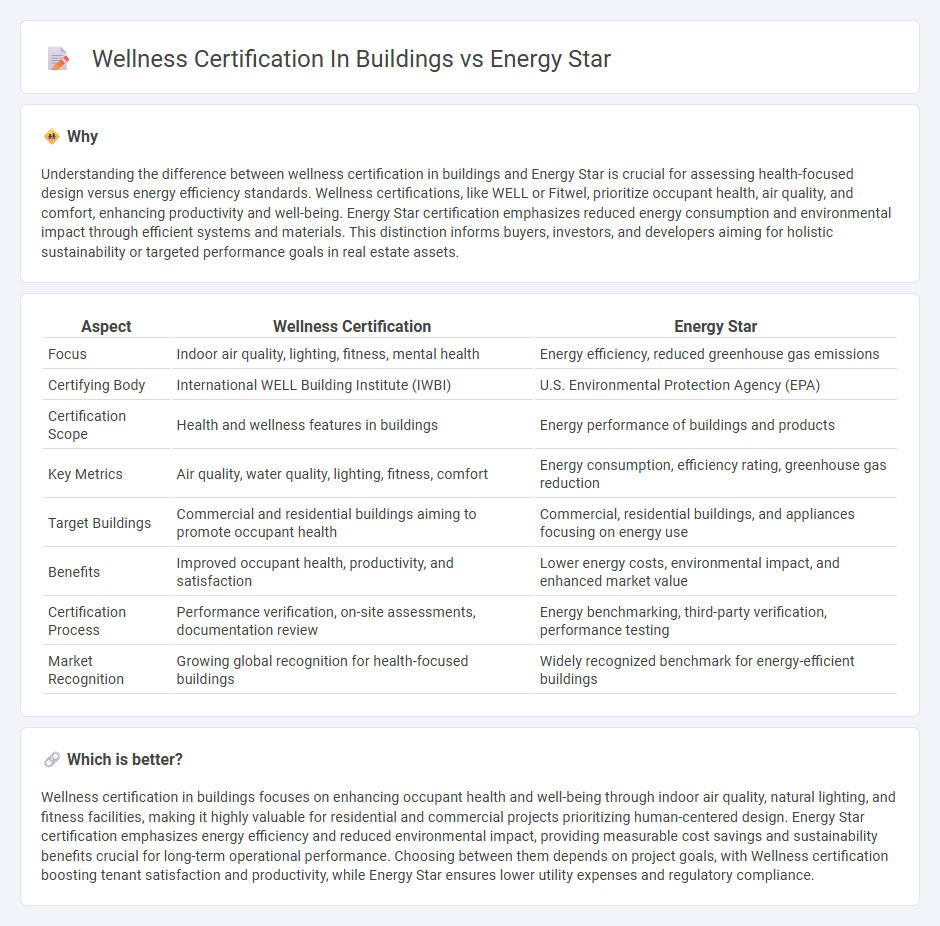
Wellness certification in buildings focuses on enhancing occupant health, comfort, and productivity through design elements such as air quality, lighting, and biophilic features. Energy Star certification emphasizes energy efficiency and reduced environmental impact by optimizing building systems and appliances to lower energy consumption. Explore how these certifications influence real estate value and sustainability standards.
Why it is important
Understanding the difference between wellness certification in buildings and Energy Star is crucial for assessing health-focused design versus energy efficiency standards. Wellness certifications, like WELL or Fitwel, prioritize occupant health, air quality, and comfort, enhancing productivity and well-being. Energy Star certification emphasizes reduced energy consumption and environmental impact through efficient systems and materials. This distinction informs buyers, investors, and developers aiming for holistic sustainability or targeted performance goals in real estate assets.
Comparison Table
| Aspect | Wellness Certification | Energy Star |
|---|---|---|
| Focus | Indoor air quality, lighting, fitness, mental health | Energy efficiency, reduced greenhouse gas emissions |
| Certifying Body | International WELL Building Institute (IWBI) | U.S. Environmental Protection Agency (EPA) |
| Certification Scope | Health and wellness features in buildings | Energy performance of buildings and products |
| Key Metrics | Air quality, water quality, lighting, fitness, comfort | Energy consumption, efficiency rating, greenhouse gas reduction |
| Target Buildings | Commercial and residential buildings aiming to promote occupant health | Commercial, residential buildings, and appliances focusing on energy use |
| Benefits | Improved occupant health, productivity, and satisfaction | Lower energy costs, environmental impact, and enhanced market value |
| Certification Process | Performance verification, on-site assessments, documentation review | Energy benchmarking, third-party verification, performance testing |
| Market Recognition | Growing global recognition for health-focused buildings | Widely recognized benchmark for energy-efficient buildings |
Which is better?
Wellness certification in buildings focuses on enhancing occupant health and well-being through indoor air quality, natural lighting, and fitness facilities, making it highly valuable for residential and commercial projects prioritizing human-centered design. Energy Star certification emphasizes energy efficiency and reduced environmental impact, providing measurable cost savings and sustainability benefits crucial for long-term operational performance. Choosing between them depends on project goals, with Wellness certification boosting tenant satisfaction and productivity, while Energy Star ensures lower utility expenses and regulatory compliance.
Connection
Wellness certification in buildings and Energy Star certification are interconnected through their shared focus on improving building performance and occupant health. Wellness certification evaluates factors like indoor air quality, lighting, and thermal comfort, directly impacting occupant well-being. Energy Star emphasizes energy efficiency and reduced environmental impact, which supports sustainable building designs that align with the wellness criteria for healthy, energy-conscious environments.
Key Terms
Energy Efficiency
Energy Star certification emphasizes superior energy efficiency by benchmarking building energy use against national standards, leading to significant reductions in utility costs and carbon emissions. Wellness certification integrates energy-efficient design with indoor environmental quality factors like air quality, lighting, and thermal comfort to promote occupant health alongside sustainability. Explore detailed comparisons and benefits to optimize your building's performance and occupant well-being.
Indoor Air Quality
Energy Star certification emphasizes energy efficiency and reducing environmental impact, indirectly supporting indoor air quality through optimized HVAC systems and reduced pollutant sources. Wellness certification prioritizes occupant health by directly addressing indoor air quality, incorporating strict standards for ventilation, pollutant control, and air monitoring. Discover more about how these certifications impact healthier building environments and occupant well-being.
Occupant Health
Energy Star certification emphasizes energy efficiency and reduced environmental impact through rigorous energy performance standards, indirectly supporting occupant health by improving indoor environmental quality. Wellness certification, such as WELL Building Standard, directly targets occupant health by promoting air quality, lighting, thermal comfort, and biophilic design to enhance physical and mental well-being. Discover more about how these certifications contribute to healthier, more sustainable building environments.
Source and External Links
Energy Star - A voluntary energy-efficiency program established in 1992 by the US Environmental Protection Agency (EPA) to promote energy-efficient products and practices.
ENERGY STAR - A joint program of the EPA and the Department of Energy (DOE) that helps consumers, businesses, and industry save money and protect the environment through energy-efficient products and practices.
Homepage | ENERGY STAR - Offers resources for saving energy, including certified products, rebates, and strategies for homes and buildings.
 dowidth.com
dowidth.com